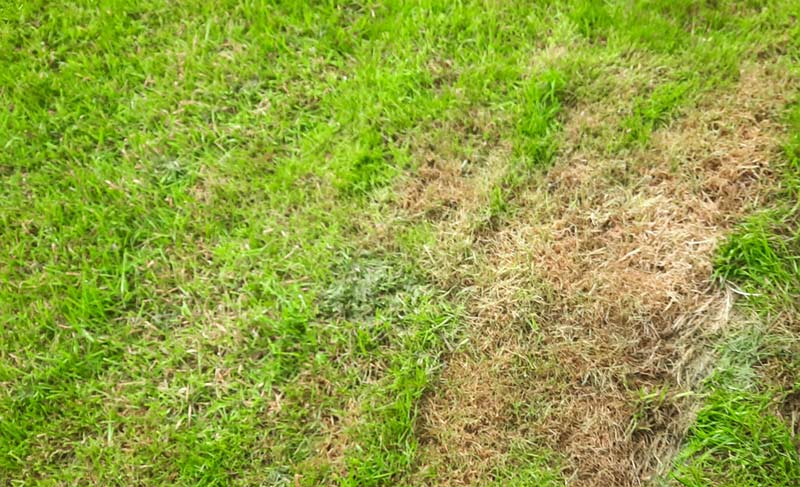If you’re wondering why parts of your lawn turn yellow and brown after you mow it, then you’ve come to the right place.
This is something that used to happen to me regularly before I became interested in lawn care.

Patches of grass that have turned brown and yellow after a recent cut.
In the photograph above, you can see that parts of the lawn have turned brown and yellow. Although the grass will eventually bounce back and turn green again, the color is unsightly. It looks as if it hasn’t been watered in weeks.
However, this was not the case. In this particular example, there had been rainfall for five straight days.
So, if it’s clearly not an issue of a lack of water, then what is it?
Why does my grass turn yellow and brown after I cut it?
In most cases, this “yellowness” will appear after you cut too much of the grass off in one mowing session.
The general rule for mowing is that you should never cut off more than one third of the grass in one go. Many lawn care enthusiasts refer to this as the “rule of thirds”.
In other words, if your grass is three inches long, only an inch should be cut off. If it is 7 inches long, then you should aim to cut off about 2 inches.
People usually get caught out by this when they allow their grass to grow higher than normal. You may have been too busy or you might have been on vacation for two weeks. Perhaps, the weather was too wet.
Either way, it happens.
Your mistake was that you cut off too much when you finally did get the chance to mow the lawn. As a result, you “stressed” the grass out and exposed its yellowy sheaths.
Most lawn mowers have a height setting that you can adjust. If you are unsure about which height you should use, then you should play it safe and set it to the highest setting available. Then, three or four days later, you can return and mow it on a lower setting.
Most people want to cut their grass as short as possible. However, this needs to be done in steps or increments.
Remember that grass is a plant. By chopping off too much of it in one go, you are essentially damaging it. As a result, it can take a week or two before it repairs itself.
What are sheaths?
In the previous section, I mentioned how cutting long grass too short can expose its sheaths.
You will notice that the longest sections of your lawn are more prone to showing yellow patches after a fresh cut. This is because you are cutting into the sheath.
A sheath is the lower section of the grass. It can be yellow or brown in color. This sheath lies beneath the green portion of your grass, around the stem. As your grass grows higher, the sheath becomes longer.
When you cut your grass too low, you are cutting off the upper green parts of the grass and exposing the lower sheaths.
In plain English, this means that you are mowing off the green section and exposing the brown section.
Thatch will also begin to show.
In the photograph above, you can see that a layer of thatch is present. Thatch is basically dead plant matter and grass that can build up on top of your soil.
Once you cut the grass short enough, this layer of brown and yellowy thatch will be exposed.
During the growing season, you should detach or scarify the sections of your lawn where thatch is building up.
You can do this by using a regular garden rake or a scarifier.
Essentially, you will need to rip the dead grass up and remove it. This will allow the soil to “breathe” again. It will also make room for your grass to grow thicker and stronger.
Although your lawn will look horrible after you have initially removed the thatch, it will typically bounce back within 2-6 weeks. If you feel as though the detaching process has left too many bare spots, then you can add a thin layer of new top soil and some grass seed.
Carrying out this process will make your lawn look much healthier.
Conclusion.
In most cases, these yellowy lawn patches will only appear after you have cut too much in one go. To prevent this, you should regularly detatch your lawn and mow it at a higher setting.
Trust me, your grass will look much healthier as a result.
If the yellowness persists, then you might want to use a lawn fertilizer, as the soil could be lacking in important chemicals such as nitrogen.